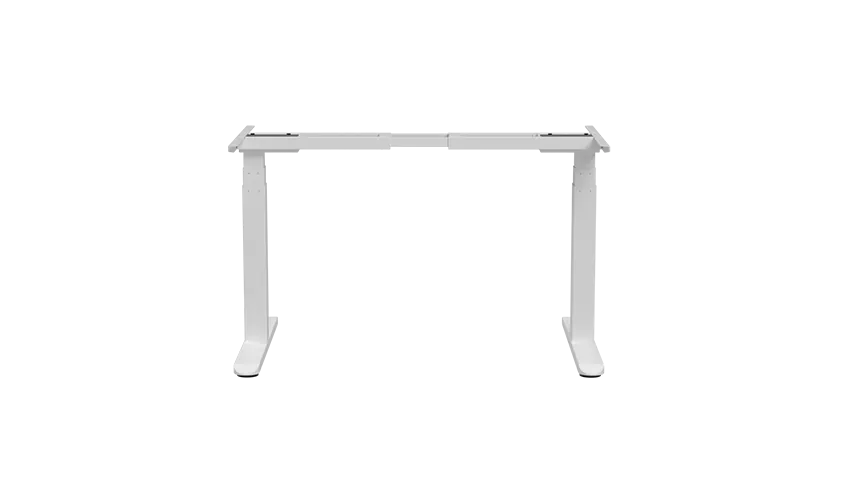Standing desks have revolutionized workspaces, promoting healthier, more ergonomic ways to work. One key feature that sets different models apart is the type of motor they use—either single or dual. This choice can impact the desk’s stability, lifting power, noise level, and price. In this guide, we’ll dive into the differences between single and dual motor standing desks to help you choose the right option for your needs.
What is a Single Motor Standing Desk?
A single motor standing desk uses one motor to lift and lower the entire desktop. This motor is typically housed in one of the desk legs, and it powers both sides of the desk using a system of gears or a central shaft.
• Pros:
• Cost-Effective: Single motor standing desks are generally more affordable than their dual motor counterparts, making them ideal for budget-conscious buyers.
• Simplicity: With fewer components, single motor desks are straightforward to maintain.
• Adequate for Lightweight Setups: For users with minimal equipment on their desks, a single motor may provide enough power.
• Cons:
• Lower Weight Capacity: Single motor desks typically support up to 80 kg, which may be limiting for heavier setups.
• Slower Adjustment Speeds: Compared to dual motors, single motors tend to lift and lower the desk more slowly.
• Potential Stability Issues: A single motor may be more prone to wobbling, especially at taller heights.
What is a Dual Motor Standing Desk?
A dual motor standing desk features a motor in each leg, which allows the desk to lift and lower with greater stability and strength. This design is typically found in higher-end standing desks and provides enhanced performance.
• Pros:
• Higher Weight Capacity: Dual motor desks can support up to 125 kg, making them suitable for heavy setups with multiple monitors and equipment.
• Faster and Smoother Adjustments: Dual motors allow for quicker, smoother height adjustments, which is beneficial for users who frequently change positions.
• Enhanced Stability: With a motor in each leg, dual motor desks are typically more stable, especially at taller heights, which is ideal for people who want to avoid desk wobble.
• Cons:
• Higher Cost: Dual motor standing desks are usually more expensive due to the additional motor and increased engineering.
• Potential for More Noise: While some dual motor desks are designed to be quiet, having two motors can sometimes increase noise levels slightly.
Key Differences Between Single and Dual Motor Standing Desks
1. Weight Capacity
• Single Motor: Typically supports up to 80 kg, suitable for basic setups.
• Dual Motor: Supports up to 125 kg, ideal for users with heavier equipment or multi-monitor setups.
2. Adjustment Speed
• Single Motor: Generally slower, which can be noticeable if you frequently switch between sitting and standing.
• Dual Motor: Faster and smoother, making transitions more efficient and comfortable.
3. Stability and Vibration
• Single Motor: May experience slight wobbling at taller heights, especially with heavier loads.
• Dual Motor: Typically more stable, as each leg operates independently, reducing wobble.
4. Noise Level
• Single Motor: Often quieter, but this varies by model.
• Dual Motor: Can be slightly noisier, though premium models are designed to minimize motor sound.
5. Price
• Single Motor: Generally more affordable, making it a good option for those who need a standing desk but are on a budget.
• Dual Motor: Costs more but provides added benefits like speed, stability, and higher weight capacity.
When to Choose a Single Motor Standing Desk
A single motor desk is a good choice if:
• You have a minimalistic setup with a laptop or single monitor.
• You’re on a tight budget but still want the benefits of a standing desk.
• You don’t frequently adjust the desk height or can work with a slightly slower adjustment speed.
When to Choose a Dual Motor Standing Desk
A dual motor desk is the better option if:
• You have a heavier setup with multiple monitors or other equipment.
• You need faster, more frequent height adjustments.
• Stability at taller heights is essential to your work setup.
• You’re willing to invest more in a standing desk for added performance and durability.
Conclusion
Choosing between a single motor and a dual motor standing desk ultimately depends on your needs, workspace setup, and budget. Single motor desks are cost-effective and sufficient for lighter setups, while dual motor desks offer greater stability, faster adjustments, and support for heavier equipment.
For a workspace that prioritizes performance and ergonomics, a dual motor standing desk is worth the investment. However, if you’re looking for a budget-friendly solution for a simpler setup, a single motor desk could be the perfect fit.


Share:
Why You Need a Reinforcement Plate for Your Monitor Arm Setup
Top 7 Common Standing Desk Problems and How to Fix Them for a Better Workspaces